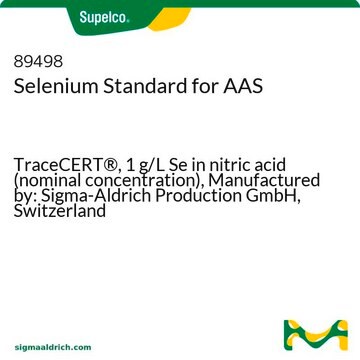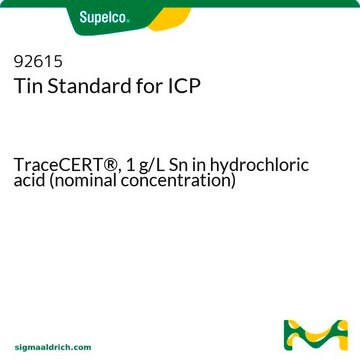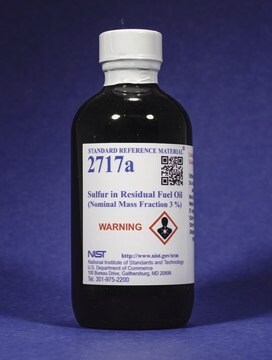30-2630
Tin standard solution
suitable for atomic absorption spectrometry, 1000 ppm Sn, 1 mg/mL Sn
Synonym(s):
Tin(II) chloride solution
Sign Into View Organizational & Contract Pricing
All Photos(1)
About This Item
Empirical Formula (Hill Notation):
SnCl2
CAS Number:
Molecular Weight:
189.62
MDL number:
UNSPSC Code:
12352302
PubChem Substance ID:
grade:
SAJ special grade
form:
liquid
Recommended Products
grade
SAJ special grade
form
liquid
availability
available only in Japan
concentration
1 mg/mL Sn
1000 ppm Sn
suitability
suitable for atomic absorption spectrometry
storage temp.
15-25°C
SMILES string
[Sn]
InChI
1S/Sn
InChI key
ATJFFYVFTNAWJD-UHFFFAOYSA-N
Looking for similar products? Visit Product Comparison Guide
Related Categories
Signal Word
Warning
Hazard Statements
Precautionary Statements
Hazard Classifications
Eye Irrit. 2 - Met. Corr. 1 - Skin Irrit. 2 - STOT SE 3
Target Organs
Respiratory system
Storage Class Code
8B - Non-combustible corrosive hazardous materials
WGK
WGK 1
Flash Point(F)
Not applicable
Flash Point(C)
Not applicable
Choose from one of the most recent versions:
Already Own This Product?
Find documentation for the products that you have recently purchased in the Document Library.
Qaisar Nadeem et al.
Pakistan journal of pharmaceutical sciences, 26(2), 353-357 (2013-03-05)
N-(2-Hydroxybenzyl)-2-amino-2-deoxy-D-glucose (NHADG) was synthesized by conjugation of salicylaldehyde to glucosamine. The obtained compound was well characterized via different analytical techniques. Labeling of the synthesized compound with technetium-99m ((99m)Tc) in pertechnetate form ((99m)Tc O4-) was carried out via chelation reaction in
Betul Cekic et al.
Acta cirurgica brasileira, 27(9), 606-610 (2012-09-01)
Since Technetium-99m ((99m)Tc) has favorable physical and chemical characteristics, it is widely used radioisotope in Nuclear Medicine. However, stannous dichloride (SnCl(2)) has been widely used as a reducing agent in labeling procedure of pharmaceutical with radionuclide, it has been realized
José Carlos Pelielo De Mattos et al.
Molecules (Basel, Switzerland), 17(11), 12974-12983 (2012-11-03)
Radiopharmaceuticals are employed in patient diagnostics and disease treatments. Concerning the diagnosis aspect, technetium-99m (99mTc) is utilized to label radiopharmaceuticals for single photon computed emission tomography (SPECT) due to its physical and chemical characteristics. 99mTc fixation on pharmaceuticals depends on
David J Hallett et al.
Organic & biomolecular chemistry, 10(30), 6130-6158 (2012-04-20)
Reactions of the allyltin trichloride 45 generated from (4S)-4-benzyloxypent-2-enyl(tributyl)stannane 1 with imines prepared from glyoxylates proceed with useful levels of 1,5-stereocontrol in favour of (4E)-2,6-anti-2-(alkylamino)-6-benzyloxyhept-4-enoates 49. This stereoselectivity, controlled by the chirality of the stannane, dominates over any intrinsic stereochemical
Brendan Wampler et al.
Journal of food science, 77(6), C677-C683 (2012-05-18)
To determine volatile formation during storage and thawing, whole, pureed, blanched, and raw green and red bell peppers (Capsicum annuum) were frozen quickly or slowly then stored at -18 °C for up to 7 mo, with and without SnCl(2) addition
Our team of scientists has experience in all areas of research including Life Science, Material Science, Chemical Synthesis, Chromatography, Analytical and many others.
Contact Technical Service







